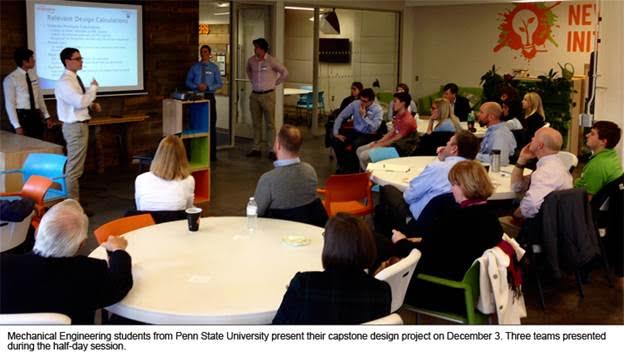The Hydraulic Institute (HI), along with member companies KCF Technologies, Engineered Software, Flowserve and NIDEC, sponsored a series of Penn State University Capstone Projects that challenged college engineering students to field solutions on complex pump engineering projects. According to the University, the mission of Capstone Design Projects is to bring the real-world into the classroom by providing engineering students with practical hands-on experience.
Working in collaboration with sponsors, as well as Penn State technicians and the University Area Joint Authority (UAJA), student groups addressed pump system efficiency issues using Internet-based sensor technologies and simulation modeling software. Two student teams sought engineering solutions to one of the biggest challenges in the industrial world: reducing pump inefficiencies that account for up to 20% to 40% of wasted electrical energy in both industrial and building services. A third team designed and built a pump test loop that was so well done that the sponsoring company intends to continue its use.
Solutions to the Capstone problem-solving projects were presented by student design teams to sponsors, faculty members, HI staff and facility management at the New Leaf Initiative Building on Penn State University Campus.
“The student design teams presented complex engineering solutions that focused on modeling and analysis of hydraulic systems at State College’s UAJA wastewater treatment facility and pumps within the Earth-Engineering Sciences Machinery Building using some outstanding engineering work,” notes Jeremy Frank, President & Co-founder, KCF Technologies.
The Capstone Design Projects included (see participating student members below):
Efficiency Analysis of a Penn State Motor/Pump System Leading to Design Recommendations to Improve Performance/Co-Sponsors: NIDEC and KCF Technologies
In this project, students initially identified a motor/pump system located on Penn State campus and collected working drawings to identify component specifications and learn about system operating conditions. Implementing a pump design software tool developed by Engineered Software, Inc. called P∙SMART and KCF Technologies’ wireless vibration monitoring kit, the design team, then, conducted an efficiency analysis of current pump system operations. Students also analyzed live vibration data (via SmartDignostics) related to the motor/pump performance within a regularly scheduled timeframe.
Design and Fabrication of a Pump Test Loop/Sponsor: Flowserve
Working to Flowserve’s specifications to design and build a pump loop for future training and testing purposes at its Bethlehem facility, students designed a piping layout, purchased necessary construction materials, assembled the loop, then, operated it using a pump and motor supplied by Flowserve. The team created a final report documenting all design decisions, appropriate drawings, proper instrumentation and assembly instructions.
Jessica Phillips, Engineering Manager, Flowserve Corporation, says, “As a fellow engineer, I was impressed how quickly these mechanical engineering students learned to design a solid pump test loop with proper instrumentation using HI standards with excellent results.
The Penn State Capstone Projects are just the beginning of HI’s endeavor to work with manufacturing members and leading engineering universities and colleges in implementing many diverse Capstone programs related to pump systems optimization. In addition to creating greater awareness of needed pump system efficiency within the pumping industries, these Capstone projects will help to recruit qualified mechanical engineering graduates to these industries.
Mark Sullivan, Director, Education & Marketing, Hydraulic Institute, explains, “Pumps touch many aspects of modern society. Our mission is to bring new engineering talent to this vital technology area. In reaching new graduates, while touting the importance of pump system efficiency, we plan to further expand our joint educational efforts with engineering schools such as Penn State.”
Students participating in Capstone Design Project focused on Efficiency Analysis of a Penn State Motor/Pump System Leading to Design Recommendations to Improve Performance:
Team One: Sarah E. Hines, Nathan Markley, Kristen M. Van Tilburg, Alyssa N. Rubinstein
Team Two: Summer L. Hyde, Mark C. Matheson, Lauren N. Phillips, Douglas H. Wissler
Students participating in Capstone Design Project focused on Design and Fabrication of a Pump Test Loop/Sponsor: Christian R. Backus, Norris Hua, Ryan T. Taylor, Nathan P. Vitacco



